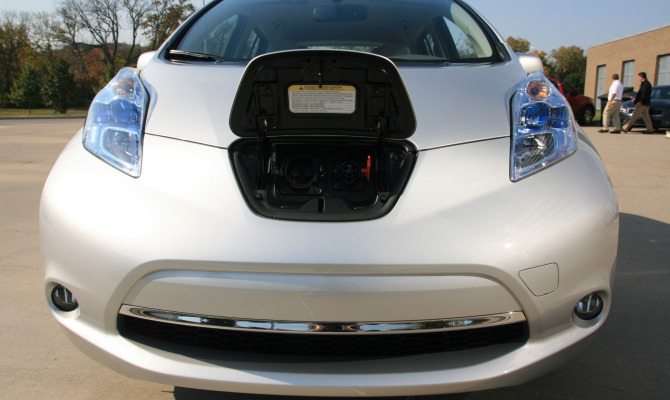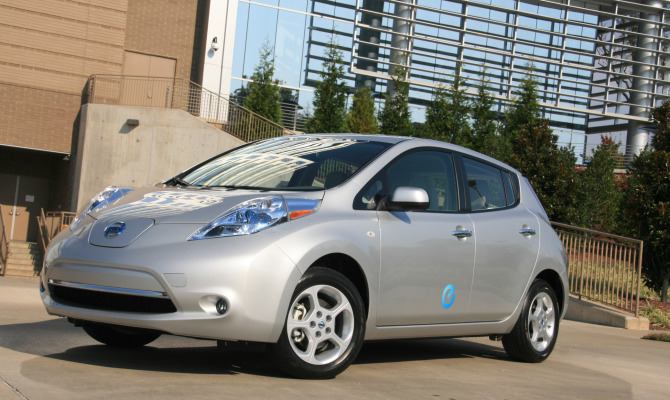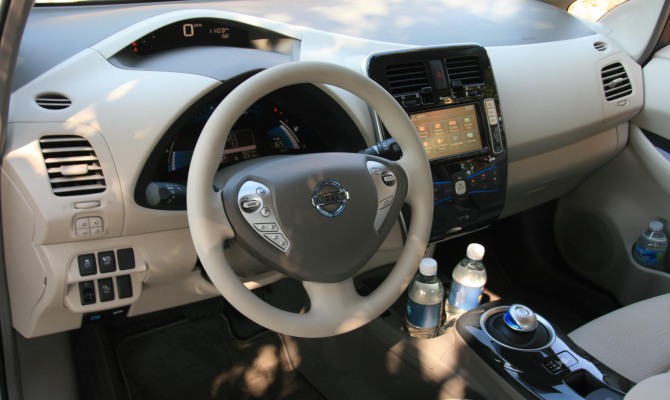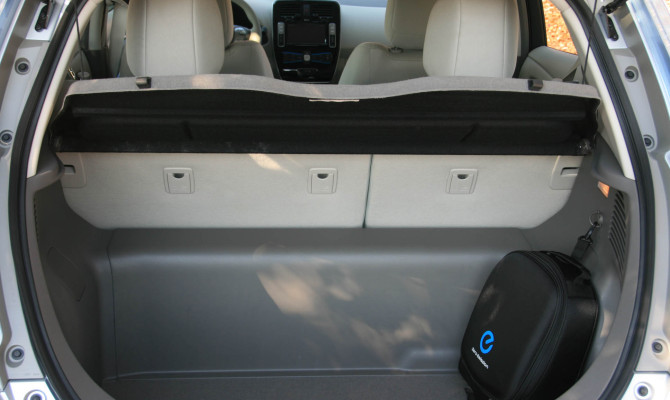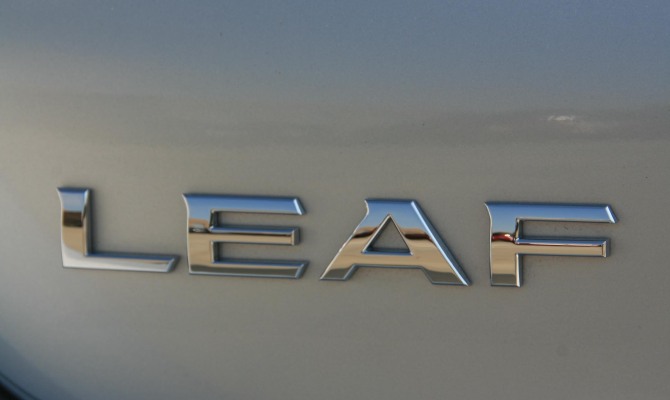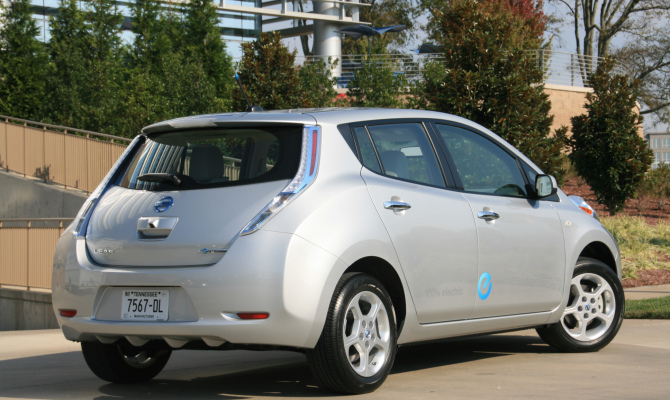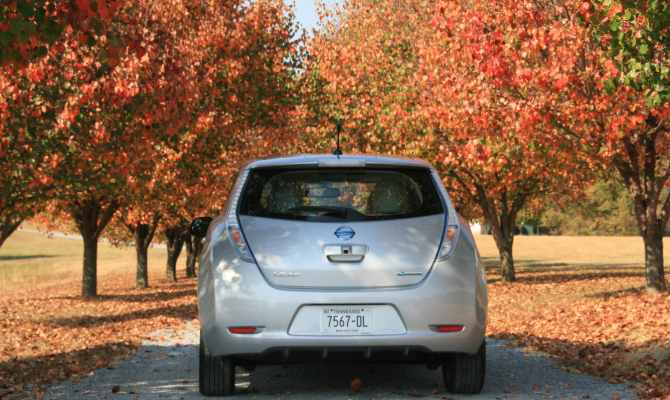“Leaf has a rated driving range of 160 kilometres on a single charge, but it’s capable of going longer distances if the conditions are right and the driver conserves power…”
The Nissan Leaf relies solely on electric power for propulsion and was the first mass production EV (electric vehicle) sold in North America.
No glorified golf cart here, the Leaf can seat up to five adults and has more than enough power to be driven a highway speeds… just like a normal car.
When Leaf was released as a 2011 model year vehicle Nissan already had pre-sale orders for its entire first-year production run of 20,000 units. Based on a stretched version of Nissan’s B-platform, Leaf uses a low-slung Lithium-Ion battery pack to store its electrical energy and it’s located near the centre of the vehicle, under the floor. In addition to ample rear cargo space, the battery position also helps make the Leaf more stable and more nimble than other EV’s.
It’s a unique air cooled flat design of battery pack with four cells and 48 laminated modules. It weighs about 250 kg (600 lbs.) and came with an eight-year/160,000 km warranty. An 80kW AC synchronous electric motor drives the Leaf’s front wheels. It can generate 107 horsepower and 207 lb-ft of torque. Leaf has a rated driving range of 160 kilometres on a single charge, but it’s capable of going longer distances if the conditions are right and the driver conserves power.
The battery pack can be charged up to 80 per cent of its full capacity within 30 minutes when connected to a dedicated (level 3) DC fast charger. A level two (typical home unit) charger hooked up to a 240V outlet can do a full charge in less than eight hours. The portable (level 1) charger can be used to top-up power and connects to any (110-volt) electrical outlet. The charger port is hidden behind a small door up front.
The ultra quiet Leaf has a speaker near the front of the vehicle that makes a humming sound, at low vehicle speeds, to alert pedestrians to its presence. Like all electric motors, full power is available immediately. The (regenerative) brake pedal feel is a little different and the lack of telescopic steering column may put-off some buyers.
The 2012 Nissan Leaf was essentially unchanged, however, the 2013 model year brought a bunch of technology upgrades and a new lower-priced base S trim level. An upgraded 6.6KW onboard charger is capable of reducing level 2 charge time (with 30-amp service) to under four hours. This Leaf also comes with an improved energy management and regenerative braking systems, a more efficient heater and improved aerodynamics.
Although the Leaf has consistently received a ‘Top Safety Pick’ rating from the Insurance Institute for Highway Safety, the 2013 edition got a ‘poor’ rating in a new (and tougher to pass) small overlap frontal crash test. This test is designed to replicate what happens when the front corner of a vehicle collides with another vehicle or a fixed object like a tree or utility pole, at 64 km/hour (40 mph).
While saving money on fuel is great, most Leaf owners are more concerned about the environment and our dependency on oil. So far, general reliability appears to be very good and EV maintenance costs are typically lower than a gas engine vehicle. Limited availability on the used car market is not too surprisingly, as most owners are hanging on to their Nissan Leaf.
**********
Price Check: 2011 – 2013 Nissan Leaf (October 2014)
Year Edition Expect to Pay Today
2011 SL $19,000 to $23,000
2012 SL $22,000 to $26,000
2013 SL $25,000 to $29,000
Prices vary depending on a used vehicle’s condition, mileage, usage and history. A complete mechanical check should always be performed by a reliable auto technician prior to purchase.
**********
Safety Recalls: 2011 to 2014 Nissan Leaf:
2013/2014: The front passenger seat occupant classification system software may incorrectly classify the passenger seat as empty and deactivate the passenger side airbag. Dealers will reprogram the occupant classification system.
2014: The front member assembly may not have been welded to specification and it may not comply with the requirements of Canada Motor Vehicle Safety Standard (CMVSS) 208 – Occupant Protection and CMVSS 305 – Electrolyte Spillage and Electrical Shock Protection. Dealers will inspect vehicles for improper welding. Vehicles found to have been improperly welded will be replaced.
Recent Comments
- { Enjoyed your Forest of Bowland in the BMW X5M, particularly the photo of the BMW in front of the main part of Stonyhurst College where... }
- { Bantam designed the Jeep, not Willy's or Ford. The American military gave the original Bantam prototype to Willys and Ford to copy. There is plenty... }
- { All Escalades come with a 6.2-lilter V8 engine that produces 420 horsepower. A six-speed automatic is the only transmission offered and drives the rear wheels.... }
- { Alexandra is an excellent journalist. }
Popular Posts
- Journey to a ‘Sparkling’ Luxury Okanagan Resort “Four lucky readers will put a Dodge Journey’s weekend-...
- The Need For Speed: Hike Those Highway Limits More than half of those polled believe the province sho...
- Drives-U-Crazy… Erratic drivers. An early morning drive from Kelowna to Vancouver is nor...
- Readers Respond: The Pros and Cons of Increasing B.C. Speed Limits Increasing the speed limits will only increase risk to...
- Honda CR-V Review: The Compact Crossover To Get Things Done The CRV is a very stylish and aerodynamic crossover veh...


